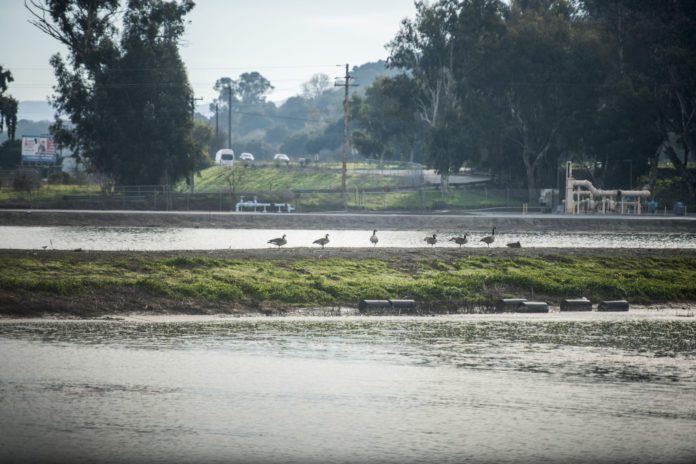Council members received a report Monday on the city’s outdated sanitary sewer management plan, currently overdue for an update.
The state water board issued Hollister a notice of violation this month for two separate 2016 wastewater spills that discharged into the San Benito River. The two spills occurred July 16 and Sept. 6, but city officials didn’t issue a public notice about the matter.
The outdated plan was included as one of 10 violations in a notice issued by the Central Coast Regional Water Quality Control Board on Jan. 13. The current plan is dated 2007 and requires an update at least every five years, the notice said.
Wallace Group Director of Public Works Administration Bill Callahan gave a presentation to council members during Monday’s meeting. The Wallace Group is a San Luis Obispo-based engineering consultant that’s worked with Hollister in the past.
Council members approved Wallace Group plans and specifications for a prefabricated fiberglass slide-gate/diversion valve on Jan. 17 relating to the San Benito Foods cannery line.
During Monday’s meeting, Callahan presented an overview of regulatory requirements, schedule, sewer system management plan and elements, supporting plans and programs, level of effort and costs, common problems, and enforcement.
Mayor Ignacio Velazquez asked Callahan how often the sewer plan is required to be updated. Callahan responded that it varies depending on the enforcement agency.
It should be noted that the regional state water board requires an update to the city’s sewer plan every five years. According to the notice of violation, the last update was in 2007, meaning it should’ve been updated in 2012.
The plan requires an audit every two years, Callahan said. Audits can be done internally or through a third party.
Although an audit is required every two years, the sanitary sewer management plan is a living document, he said. Part of the plan called for monitoring, measuring and modifying the blueprint as time goes on.
“This is something that you’re supposed to do regularly; it could be quarterly, semiannually or annually,” Callahan said. “A lot of people fall into the trap of saying, ‘Well we’re just going to audit our (sanitary sewer management plan) every two years.’ That’s not adequate. That’s why they have this element as part of the management plan.”
Communication with the public was another important part of the plan.
“This is another element of the (sewer plan), which you’re required to perform regular outreach to the public to let them know how you’re performing, what your (sewer plan) says and regular reporting to the city council,” Callahan said. “You can do that as part of your monitoring and reporting program. You’re supposed to allow for an opportunity for public input and education regarding the (sewer plan). So as your (sewer plan), say, is developed or when you do audits, you have to allow a public opportunity to have input or ask questions.”
After the presentation, Velazquez asked where the City of Hollister is currently with the plan.
“Wallace Group has been working on this for several months; this is not something that just came up yesterday,” City Manager Bill Avera said.
Avera said the item was originally agendized for Jan. 9, but was moved due to scheduling conflicts.
Velazquez questioned if the city had been in compliance.
“We performed the audit of the city’s (sanitary sewer management plan) a couple years ago, year and a half ago, and I mean yeah, you do and you did have some systems in place,” Callahan said. “Really, the audit just shows you what are your strengths and weaknesses. It’s a tool.”
Velazquez wondered how many sanitary sewer overflows happen in the city each year. Earlier in the presentation, Callahan said that fat, oil and grease (FOG) have “historically” been an issue for the City of Hollister. Between 2010 and 2015, 97 percent of sanitary sewer overflows were related to fat, oil and grease, he said.
“How many of these overflows do we have a year?” Velazquez asked. “You said you don’t want to be going over five. The goal is not to go over five. What have we been doing here?”
City staff said they couldn’t answer off hand.
However, data from the state water board showed two sanitary sewer overflows between Jan. 2015 through 2016: those July 16 and Sept. 6 wastewater spills.
During his presentation, Callahan went over possible enforcement actions for being out of compliance, which included fines.
“Some of these fines can be retroactive,” Callahan said. “The state talks about economic benefit, which essentially means the date you’re expected to implement your plan, the average cost similar agencies spent to implement a similar plan, plus additional penalties. That’s how they can assess fines for you.”
Callahan said the water board would continue to check to make sure any violations have been corrected.
“They’ll continuously to re-inspect to make sure violations have been corrected, and that you have made a commitment to implement things that are supposed to be done to correct whatever violation you have,” Callahan said.










